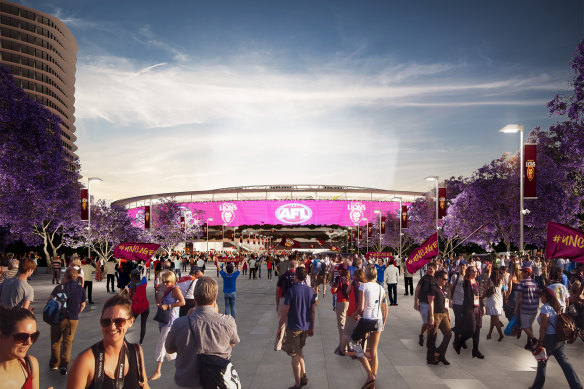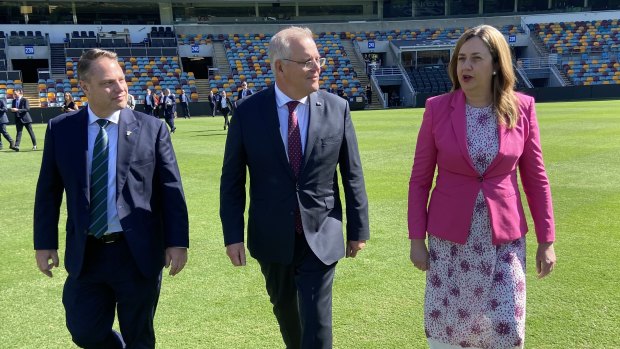This was published 3 years ago
Gabba funding hurdle cleared for Olympic stadium
The famous stadium was not part of the long-awaited south-east Queensland City Deal, but the rebirth of Brisbane’s home of cricket and AFL as an Olympic venue appeared on firmer ground on Monday as the Commonwealth warmed to the idea.
But the bulldozers would not move in on the Gabba until Cross River Rail was fully operational, Premier Annastacia Palaszczuk said as she trumpeted the City Deal funding pact between her government, the Commonwealth and the Council of Mayors (SEQ).

The Gabba, home of the Brisbane Lions, will be rebuilt for the 2032 Brisbane Olympic Games.Credit: Queensland Government - Artists’ impression
“It actually works really well because Cross River Rail will be finished and then the demolition work can start on this [stadium],” she said.
“So we’re doing one piece first and then the next piece, but it’ll all be finished well in advance of the 2032 Olympics.”
Ms Palaszczuk’s announcement the Gabba would be the main stadium for the Brisbane 2032 Olympic and Paralympic Games was received with ambivalence from Canberra.
As the Premier met with Prime Minister Scott Morrison and other representatives from federal and local governments at the Gabba on Monday to sign the deal, she hinted at progress on the $1 billion project.
“The Prime Minister and I actually agree to the funding envelope for that, so there’s no issues with that at all,” she said, with Mr Morrison standing behind her left shoulder.

Lord mayor Adrian Schrinner, Prime Minister Scott Morrison and Premier Annastacia Palaszczuk at the Gabba to sign the SEQ City Deal.Credit: Tony Moore
Earlier in the day, Mr Morrison told Brisbane radio station 4BC the federal government was committed to an even funding split for Olympics infrastructure.
“We’ve got our infrastructure partnerships, as you know, that’s a 50-50 arrangement on the major pieces of infrastructure,” he said, when asked about Gabba funding.
“We’re sticking to that deal and the Premier and I, I’m sure we’ll have more discussions about all that, so that’s all proceeding and we’re working together well on that.”
The Games were repeatedly cited as a motive for the City Deal, which would fast-track already needed infrastructure with the added incentive of a literal finishing line.
The biggest piece of expenditure within the City Deal was the Brisbane Metro station at Woolloongabba, which would cost $450 million.
There, the metro will link with the state government’s self-funded Cross River Rail and service the stadium and surrounding areas.
When queried about the hefty price tag, Mr Morrison said the metro station would be a “complex” project.
“Projects are different and they are defined by the needs and the planning of the future in those cities,” he said.
His Urban Infrastructure Minister, Paul Fletcher, outlined its importance to a successful Games.
“That Gabba station is going to be enormously important as the interface between heavy rail between Brisbane Metro, very important to meet the needs of the city as it grows and people commuting into and out of the city, but also very important to meet the needs for the Olympics,” he said.
Ms Palaszczuk’s federal Labor colleagues, however, were less than enthusiastic about the City Deal.
In a joint statement, Labor infrastructure spokeswoman Catherine King and cities spokesman Andrew Giles took aim at just one of the parties to the City Deal as they criticised its scope.
“Even with today’s announcement, the inexplicable exclusion of the Gold Coast from the City Deal, despite being home to more than 600,000 south-east Queenslanders and playing an important role in the 2032 Olympics and Paralympics, clearly shows the Morrison-Joyce government isn’t interested in ensuring the future success of the whole of the SEQ region,” they said.
But that overlooked an important detail — that the Gold Coast had voluntarily walked away from the Council of Mayors, and the SEQ City Deal was a pact between that body and the state and federal governments.
“The [Gold Coast] is best placed to do its lobbying and its advocacy directly,” Gold Coast mayor Tom Tate said as he severed ties with the organisation in 2013.
Regardless, Ms Palaszczuk said, the Gold Coast had already undergone major infrastructure improvements for the 2018 Commonwealth Games.
“A lot of that infrastructure that was built for the Commonwealth Games is going to be used for the Olympics, and also we’ve committed a lot of money for the continuation, both at the federal level, state and council, for the light rail as well,” she said.
“So when you add all of that in as well, it’s a very huge piece of investment in infrastructure.”